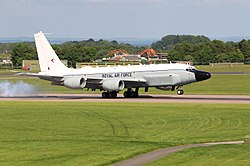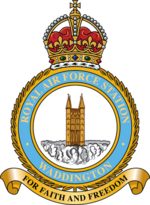|
RAF Waddington
Royal Air Force Waddington (IATA: WTN, ICAO: EGXW), commonly known as RAF Waddington, and informally known by its nickname 'Waddo'[5] is a Royal Air Force station located beside the village of Waddington, 4.2 miles (6.8 kilometres) south of Lincoln, Lincolnshire, in England. The station is the RAF's Intelligence Surveillance Target Acquisition and Reconnaissance (ISTAR) hub. It is home to a fleet of aircraft composed of the Beechcraft Shadow R1, Boeing RC-135W Rivet Joint, and General Atomics MQ-9 Reaper remotely piloted aircraft. Since October 2022, it has also been home to the RAF's Aerobatic Team the Red Arrows. HistoryFirst World War Waddington station opened as a Royal Flying Corps flying training aerodrome in 1916. Student pilots, including members of the US Army, were taught to fly a variety of aircraft. The station came under the control of the Royal Air Force (RAF) when it was created on 1 April 1918. It operated until 1920, when the station went into care and maintenance.[6] During and after the First World War, the following squadrons operated from Waddington.
Interwar periodAs part of the pre-war expansion programme, the Waddington site was earmarked for development into a fully equipped heavy bomber station. It reopened as a bomber base on 12 March 1937,[6] with No. 50 Squadron arriving on the same day with their Hawker Hinds and then adding the Handley Page Hampden.[14] No. 110 Squadron arrived 15 days later, initially with the Hind before switching to the Bristol Blenheim.[15] On 7 June 1937, No. 88 Squadron reformed at Waddington with the Hind before moving to RAF Boscombe Down in Wiltshire on 17 July 1937.[16] On 16 June 1937, No. 44 Squadron moved in from RAF Andover, flying the Blenheim, before switching to the Avro Anson and the Hampden in February 1939.[17] In May 1939, No. 110 Squadron left for RAF Wattisham in Suffolk. No. 50 Squadron left the following year, being moved to RAF Lindholme in South Yorkshire.[14][15] Second World War RAF Waddington began the Second World War housing the Hampdens of No. 44 Squadron and No. 50 Squadron. Both squadrons were in action on the same day as Britain's war declaration, attacking German naval targets at Kiel.[6][18] Waddington squadrons were also involved during the critical stages of the late summer and early autumn of 1940, attacking barges in the channel ports which were being assembled as part of the invasion fleet.[6] In November 1940, it was the first station to receive the Avro Manchester heavy bomber.[19] No. 44 Squadron RAF was the first in RAF Bomber Command to fly operationally with the Avro Lancaster on 2 March 1942 from Waddington.[19] BT308, the first prototype Lancaster (or Mk.III Manchester), arrived at Waddington in September 1941 for flight tests. Like RAF Scampton, the station was part of 5 Group.[20] On 17 April 1942, seven Lancasters of No. 44 Squadron took off from Waddington as part of Operation Margin, a bombing raid on the MAN U-boat engine plant in Augsburg in Germany.[21] The squadron subsequently left Waddington on 31 May 1943, moving to RAF Dunholme Lodge, also in Lincolnshire.[17] During the Second World War the following squadrons are known to have operated from Waddington.

In May 1975, some of the former Australian aircrew returned to the base.[28] Cold WarDuring the Cold War, RAF Waddington became an Avro Vulcan V-bomber station, with No. 83 Squadron being the first in the RAF to receive the Vulcan in May 1957. It continued in this role until 1984, when the last Vulcan squadron, No. 50 Squadron, disbanded. From 1968, the UK nuclear deterrent was transferred to Polaris submarines, beginning with HMS Resolution (S22).[29] In August 1960, the station developed the 'sudsmobile' technique to lay a 1,000 by 30 yards (914 by 27 metres) carpet of foam in around a half-hour for a wheels-up landing. Previously it had taken around three hours to lay a foam carpet on the runway. An English Electric Canberra from RAF Wyton landed wheels-up on 23 August 1960, with a Handley Page Victor managing the same on 5 December 1960.[30]  The fiftieth anniversary of the Royal Air Force was celebrated at the base on 1 April 1968, mainly because the RAF's last flying Lancaster was based at the airfield from the mid-1960s.[31] During the Cold War the following squadrons are known to have operated from Waddington.
RAF Waddington was home to several USAF Coronet deployments throughout the Cold War:
Falklands War During the Falklands War, Operation Black Buck saw three aircraft and crews from Waddington take part in a long-range bombing raid on Port Stanley airfield in the Falkland Islands. The three Vulcan B2s, of No. 44 Squadron, No. 50 Squadron, and No. 101 Squadron, were twenty-two years old, and were selected because they had the more powerful Rolls-Royce Olympus 301 engines.[42] A complicated air-to-air refuelling plan, involving fourteen Handley Page Victor K.2 tankers, was developed,[43] which was only contemplated due to the belief of Sir Mike Beetham, then Chief of the Air Staff, who had developed the RAF's in-flight refuelling capability with Vickers Valiants with 214 Squadron at RAF Marham in 1959. Spare parts for the operation were requisitioned from scrapyards in Newark-on-Trent and military museums. The K2 Victor tanker aircraft came from 55 Squadron and 57 Squadron at RAF Marham. Navigation came from the Delco Carousel inertial navigation system.[44] Later during 1982, there was a female peace camp outside the base for five months.[45] 1990s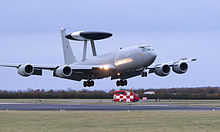 In July 1991, No. 8 Squadron moved to RAF Waddington and re-equipped with Boeing E-3 Sentrys.[46] In 1993, the only RAF Avro Vulcan bomber maintained by RAF Waddington for flying displays, XH558, was retired due to budget restraints to Bruntingthorpe Aerodrome, Leicestershire.[47] The Electronic Warfare Operational Support Element (EWOSE – now known as the Air Warfare Centre) moved from RAF Wyton to Waddington in March 1995.[48] In 1998, 26 Squadron RAF Regiment moved to RAF Waddington from RAF Laarbruch in Germany. The squadron was equipped with the Rapier Field standard C short range air defence missile system, and remained at Waddington until its temporary disbandment in 2008.[49] 21st century All of the aircraft-operating squadrons based at RAF Waddington were dispersed to other airfields in July 2014 when the runway was closed for rebuilding.[50] The project, valued at £35 million and due to take 12 months, actually took 26 months, and re-opened to aircraft officially in November 2016. The work was expected to increase the operational capability of the runway and airfield by 25 years.[51] No. 216 Squadron reformed at Waddington on 1 April 2020 as an experimental unit testing future drone swarm technology.[52] In September 2020, work to convert an existing aircraft hangar into a joint flight simulator training facility was completed. The facility, operated by the Air Battlespace Training Centre, allows simulators at different locations to be linked together, enabling UK and US crews to train with one another in scenarios which would be difficult to recreate in real life.[53][54] No. 5 (Army Co-operation) Squadron was disbanded in March 2021 when the Sentinel R1 was withdrawn from service.[55] The E-3D Sentry was also retired in 2021, with No. 8 Squadron subsequently relocating to RAF Lossiemouth to re-equip with the Wedgetail AEW1.[56] In August 2022, No. 39 Squadron disbanded, with a MQ-9A Reaper ground control system returning from Creech Air Force Base in Nevada to Waddington for use by No. 13 Squadron, which continued to operate the Reaper.[57] During early October 2022, the RAF Aerobatic Team; the Red Arrows and its 146 personnel relocated to Waddington from its previous home at RAF Scampton which was scheduled to close.[58]  No. 31 Squadron was re-formed at Waddington in October 2023, equipped with the General Atomics MQ-9B, a remotely piloted air system which is known as the Protector RG1 in RAF service.[59] A new hangar, support facilities and crew accommodation were constructed at Waddington; in 2018 it was said that the cost of this project would be £93 million.[60] Role and operationsISTAR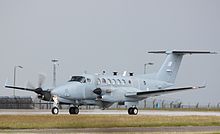 RAF Waddington is the RAF's Intelligence Surveillance Target Acquisition and Reconnaissance (ISTAR) hub, and is home to a fleet of aircraft composed of Shadow R1 and RC-135W Rivet Joint, and is an operating base for the RAF's MQ-9 Reaper.[61] No. 1 Intelligence Surveillance Reconnaissance Wing formed on 1 April 2016. It is a mix of the staff and capabilities of the Tactical Imagery Intelligence Wing (TIW) at RAF Marham, No. 54 Signals Unit at RAF Digby, and No. 5 (AC) Squadron. Waddington is home to the wing headquarters.[62] Expeditionary Air WingVarious units and squadrons were combined to form a new deployable air force structure, No. 34 Expeditionary Air Wing (34 EAW), at RAF Waddington on 1 April 2006.[63] Supported unitsRAF Waddington Voluntary Band is one of seven voluntary bands within the Royal Air Force.[64] Amateur radio licensees are not allowed to operate unattended radio beacon transmitters on 28.000–29.700 MHz, 10.000–10.125 GHz, 24.000–24.050 GHz, or 47.000–47.200 GHz within 50 kilometres (31 miles) of the Waddington airfield, centred on Ordnance Survey Grid Reference SK 985640.[65] Based unitsThe following notable flying and non-flying units are based at RAF Waddington:[66][67]
HeritageStation badge and mottoThe station badge depicts Lincoln Cathedral rising through the clouds, with the motto 'For Faith and Freedom' emblazoned below.[6] Gate guardians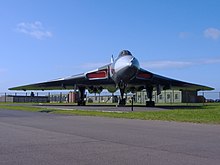 The gate guardian at RAF Waddington is Avro Vulcan XM607, one of three Vulcan bombers (XM597, XM598, XM607) which took part in Operation Black Buck raids between April and June 1982 during the Falklands War. XM607 was stationed at Waddington and took part in the raids, captained by pilots Flight Lieutenant Martin Withers (on mission 1 and 7) and by Squadron Leader John Reeve (on mission 2).[69] In 1984, along with all other remaining Vulcans, XM607 was retired from active service, and was preserved as the gate guardian at Waddington.[69] A Hawker Hunter F.6A acts as gate guardian outside the No. 8 Squadron facilities at Waddington. Styled as XE620 in No. 8 Squadron markings, the aircraft was originally XE606.[70] List of Station Commanders
Previous unitsThe following units were also stationed at Waddington at some point:[75]
Waddington International Airshow The first RAF Waddington International Airshow was staged at RAF Waddington in 1995, after the event was moved south from RAF Finningley, a now former Royal Air Force station east of Doncaster (now known Robin Hood Airport Doncaster Sheffield) which was closed in that year. Over the following years the RAF Waddington International Airshow developed into the largest of all Royal Air Force air shows. It took place on the first weekend in July, attracting over 140,000 visitors and representatives of air forces from all round the world. The main purpose of the show was to raise public awareness and understanding of the Royal Air Force and its role today. Eighty five percent of the proceeds from the event were distributed to the two main Service charities, the RAF Benevolent Fund (RAFBF) and the RAF Association (RAFA); the remaining 15% was donated to local causes. Since 1995, the airshow has raised almost £3 million for Service and local charities.[90] In 2015, the station was earmarked for development, a significant part of which being concerned with the station's runway, with work scheduled for 59 weeks. This therefore ruled out an airshow during 2015. The timing of the works coincided with a review of the station in general, the continuance of the airshow being also part of the review. The outcome was that having weighed up the content of the report, it was decided that: "significant security risks as well as certain operational risks" resulted from the operation of the RAF Waddington Airshow, and therefore the airshow, for the reasons cited, would not be continued with.[91] These security risks have generally centred on RAF Waddington being used as a base for the operation of Reaper drones.[92] In February 2016, it was announced that following an agreement between the Royal Air Force and the Royal Air Force Charitable Trust, the venue of the airshow would switch from RAF Waddington to RAF Scampton, with the hope that the airshow would be resurrected in 2017.[91] See alsoReferencesCitations
Bibliography
External linksWikimedia Commons has media related to RAF Waddington. |
||||||||||||||||||||||||||||||||||||||||||||||||||||||||||
